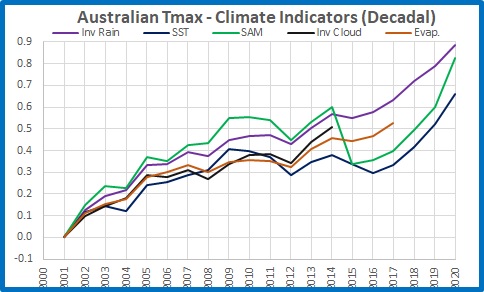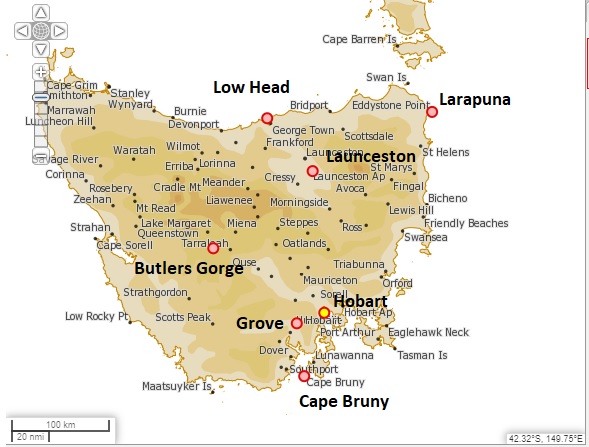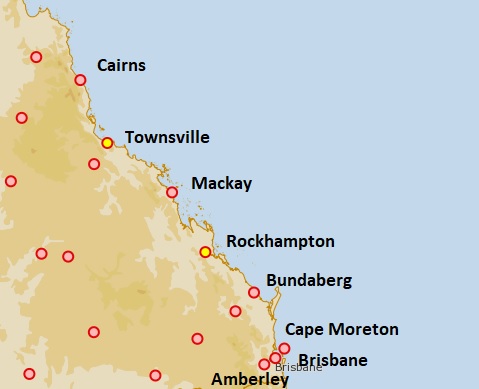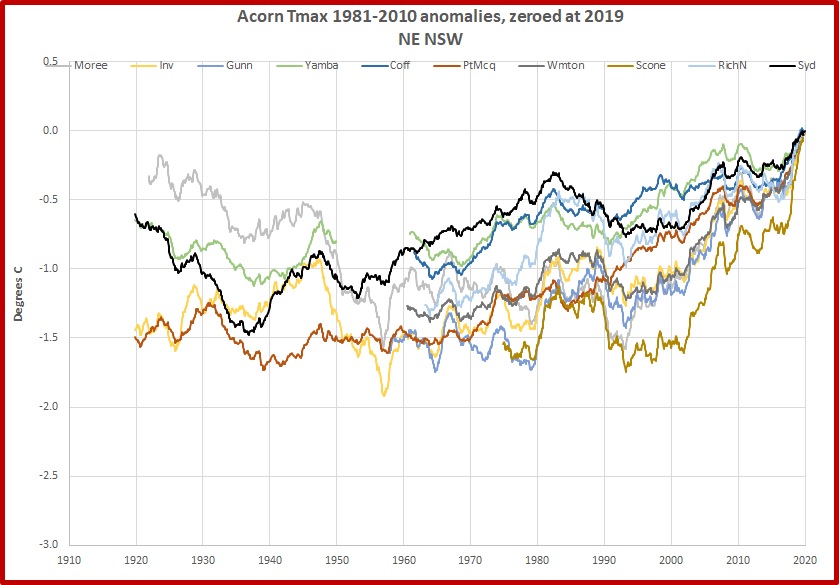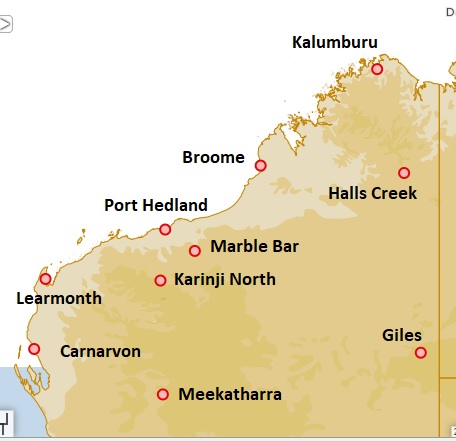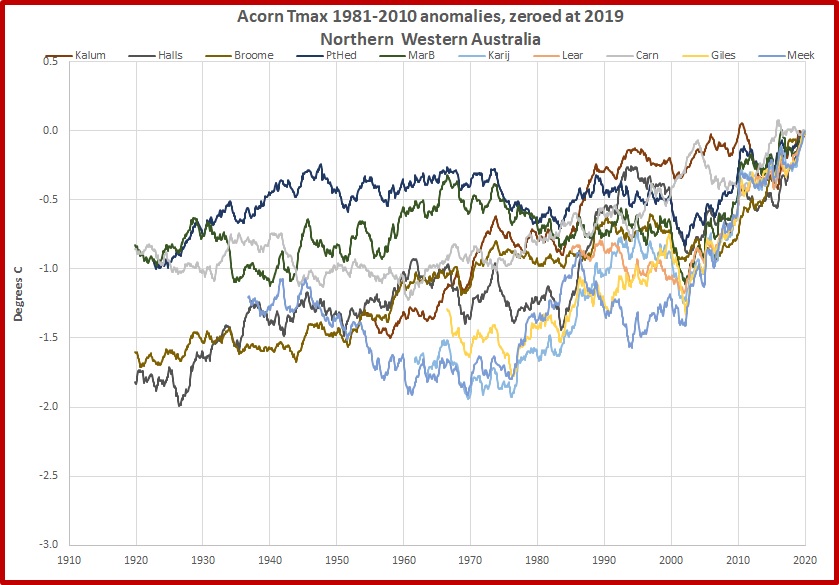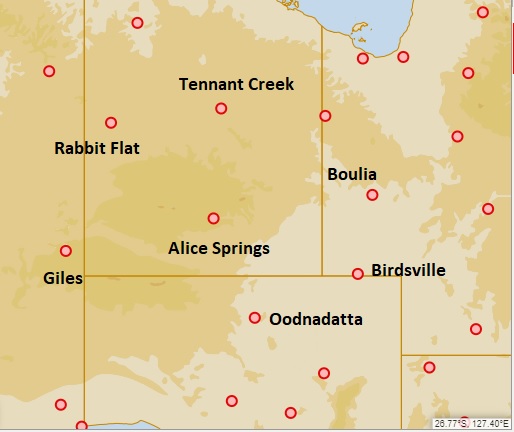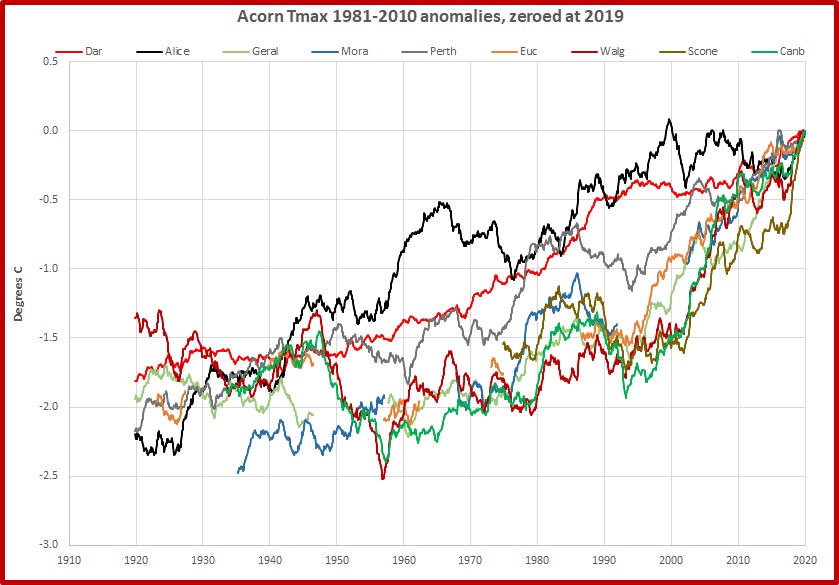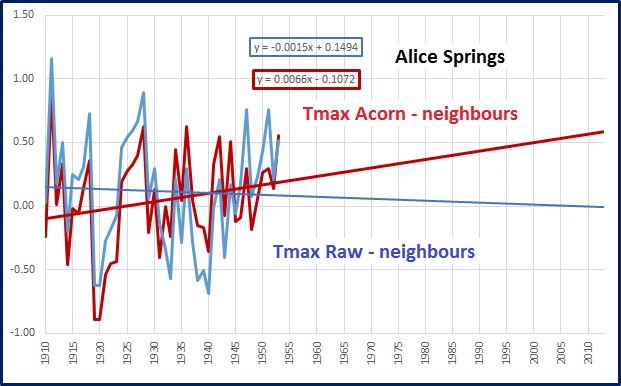In my last post I showed that Australia wide the Tmax ~ rainfall relationship has remained constant for the past 110 years (as it should) but Tmax reported in the Acorn dataset has increased by more than 1.5 degrees Celsius relative to rainfall. Consequently, the ACORN-SAT temperature dataset is an unreliable record of Australia’s maximum temperatures.
Of course there are other aspects of climate besides rainfall. In this post I will compare annual ACORN-SAT Tmax data with:
Rainfall
Sea Surface Temperatures (SST)
The Southern Annular Mode (SAM)
Cloudiness
Evaporation
all for the Australian region.
I have sourced all data from the Bureau of Meteorology’s Climate time Series pages
except for SAM data from Marshall, Gareth & National Center for Atmospheric Research Staff (Eds). Last modified 19 Mar 2018. “The Climate Data Guide: Marshall Southern Annular Mode (SAM) Index (Station-based).”
Tmax, Rainfall, and SST data are from 1910; SAM and Daytime Cloud from 1957, and Pan Evaporation from 1975. Cloud observations apparently ceased after 2014, and Evaporation after 2017, possibly because of staffing cuts.
Because Pan Evaporation data are only available from 1975 and are reported as anomalies from 1975 to 2004 means, I have recalculated Tmax, Rainfall, SST, SAM, and Daytime Cloud anomalies for the same period so all data are directly comparable.
As in the previous post, I have calculated decadal averages for all indicators to show broad long term climate changes. Decadal averages show how indicators perform over longer periods. Each point in the figures below shows the average of the 10 years to that point. This can then indicate times of sudden shifts or questionable data. (For example in Figure 1 SAM (the green line) makes a sudden jump in 2015. Was this a climate shift or a data problem?)
Figure 1 shows the 10 year means for all climate indicators. I have scaled Rain and SST to match Tmax at 2019, Cloud and SAM to match Tmax at 1966, and Evaporation to match Tmax in 1984. Rain and Cloud are inverted as they have an inverse relationship with temperature.
Figure 1: 10 Year Means of Climate Indicators
Tmax has stayed close to SST until 2001. Clearly Tmax has increased far more than any of the others, especially since 2001.
The next plots show the difference between decadal averages of Tmax and the other indicators. Zero difference means an excellent relationship with Tmax.
Figure 2: Difference: 10 Year Means of Tmax minus Rain and SSTs.
Starting from 1919 (zero difference), Rainfall is close to Tmax until 1957, after which Tmax takes off until it is 1.6 degrees Celsius greater than expected in the 10 years to 2020. Tmax diverges from SST values in 2001 and in 2020 is 0.7 degrees greater than expected.
In Figure 3, Rain, SST, SAM, and Cloudiness are scaled to match Tmax at 1966.
Figure 3: Difference: 10 Year Means of Tmax minus Rain, SST, SAM, and Cloud
Figure 3 shows how closely Rain and Cloud are related: differences from Tmax are almost identical. Compared with 1966, Tmax is 1.3 degrees more than rainfall would suggest in the 10 years to 2020. SST and the SAM index are less different from Tmax but Tmax divergence is still clear. You may notice that Tmax differences from all climate indicators seem to change at similar times, apart from SAM in 2015.
In Figure 4, all indicators are scaled to match Tmax at 1984.
Figure 4: Difference: 10 Year Means of Tmax minus Rain, SST, SAM, Cloud and Evaporation
Differences increase rapidly after 2001, so in Figure 5 indicators match Tmax at 2001.
Figure 5: Difference: 10 Year Means of Tmax minus Rain, SST, SAM, Cloud and Evaporation
There appears to be a problem with SAM in 2015, and it’s a shame that the BOM have discontinued Cloud and Evaporation observations. In the last 20 years, it is obvious that Tmax has diverged from other indicators.
Conclusion:
All factors- Rainfall, SAM, SST, Clouds, and Pan Evaporation- point to a clear divergence of temperature nationwide, especially in the last 20 years. In other words, ACORN-SAT, our official record of temperatures, is unreliable.




